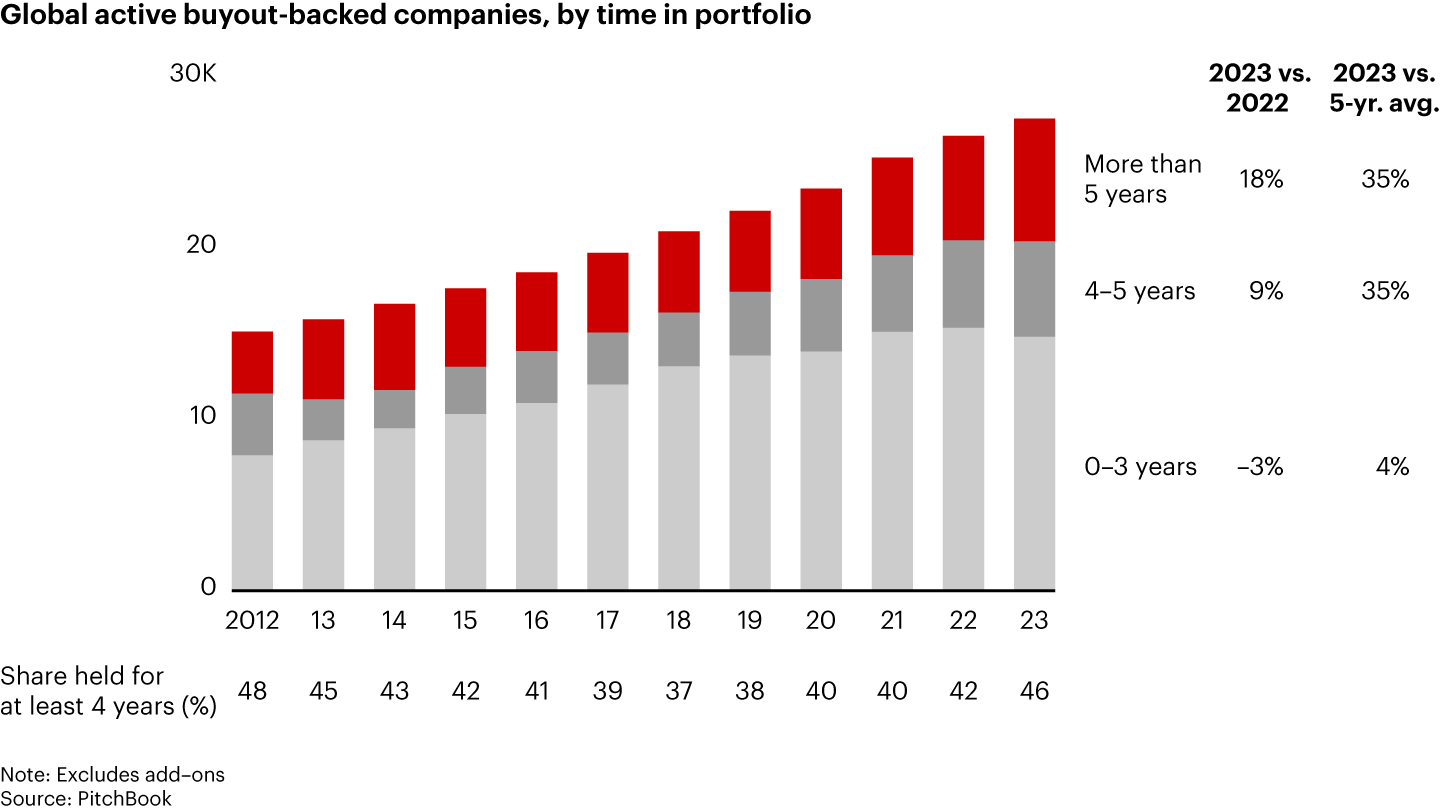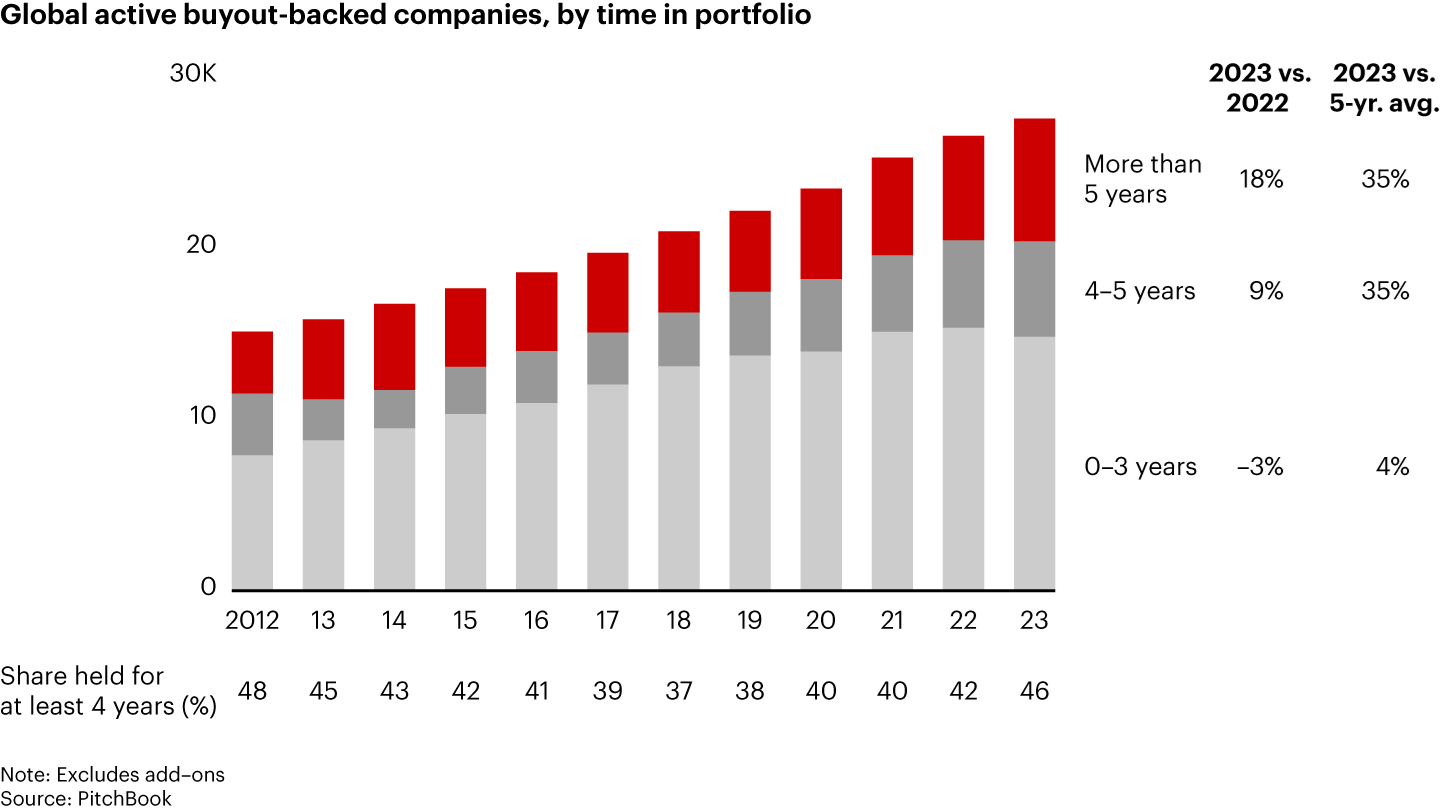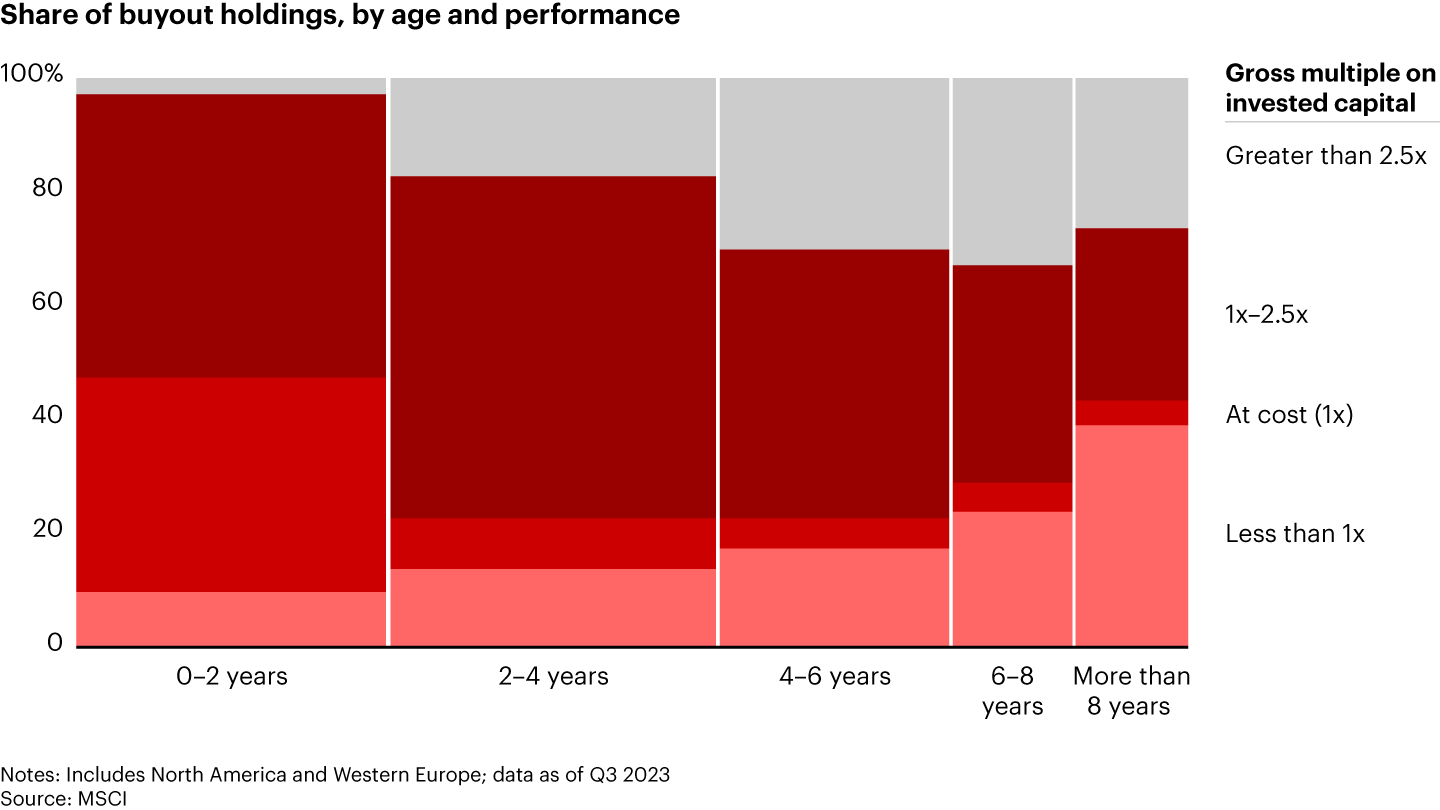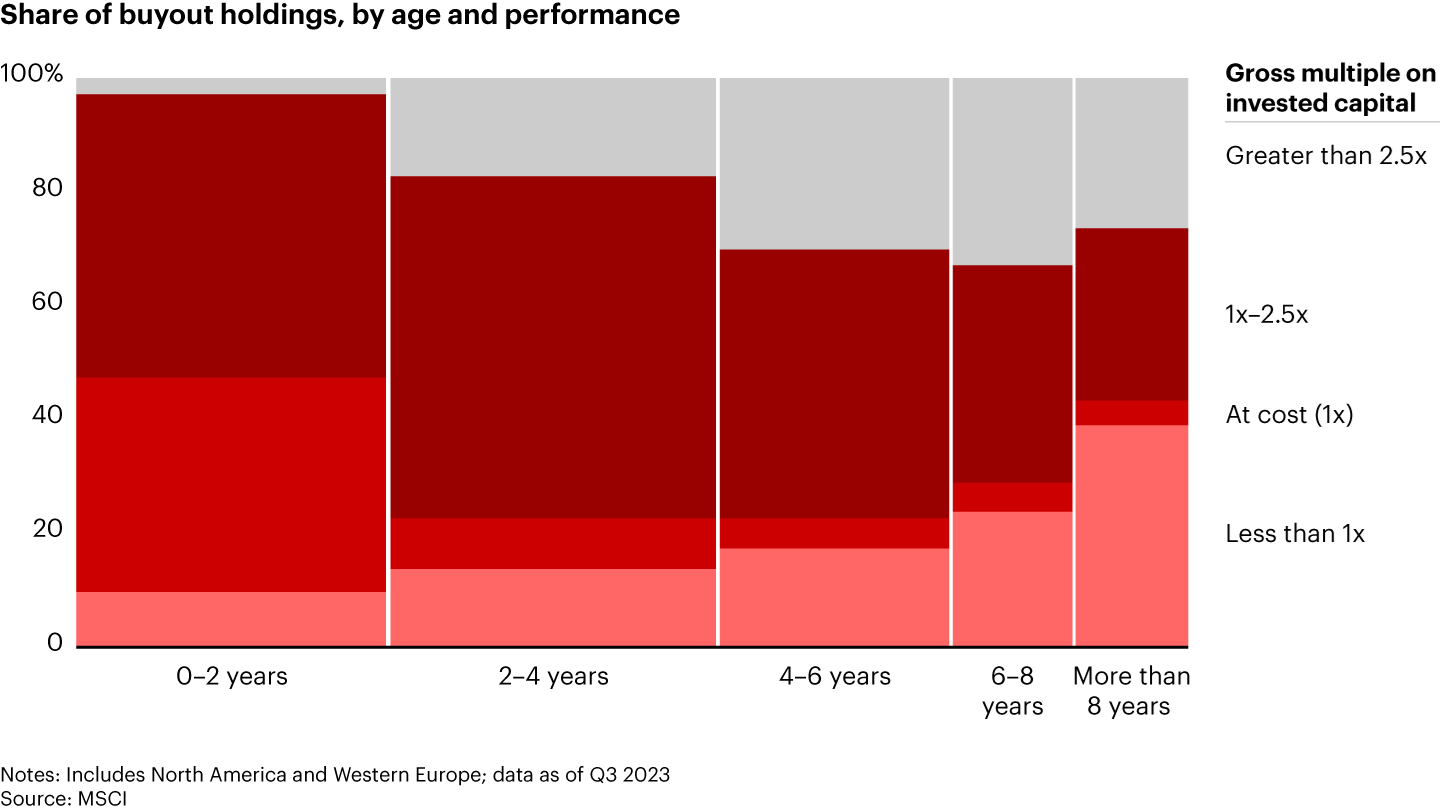Global Private Equity Report

한눈에 보기
- With exit channels in deep freeze, unsold assets are piling up in private equity portfolios, preventing distributions to investors and threatening future fund-raising.
- If rates ease in the coming year, exits should recover faster than they did in the wake of the global financial crisis.
- Even so, GPs need to prioritize getting capital back to LPs by developing comprehensive, pragmatic strategies to generate near-term exits.
This article is part of Bain’s 2024 Global Private Equity Report
The 2006 vintage of buyout funds will always be remembered with a certain measure of dread by private equity investors who lived through the global financial crisis (GFC).
Things turned out all right in the end, but getting there was a slow-motion slog through the mud.
Most fund vintages follow a predictable “J curve” that plots cash flows from inception to close. General partners (GPs) call the capital, it gets invested, and then it takes around seven years to generate distributions that exceed the original capital outlays.
But 2006 was different (see Figure 1).
In the lead-up to the GFC, a record amount of capital got called and invested just before the financial markets collapsed. Amid the ensuing recession, exit markets seized up, deals transacted at peak valuations suddenly faced trouble, and all that investor capital froze in place. It took 10 years for the vintage to start generating positive cash flows, leaving 2006 as the poster child for what happens when unusually rapid investment is followed by sudden economic disruption.
Why dig up such a painful episode? Because drawdowns from recent fund vintages are tracking the 2006 vintage closely (adjusted for industry size). After an initial flurry of postpandemic investment activity (also at record-high multiples), exit markets abruptly shut down amid rising interest rates, stanching the flow of capital back to limited partners (LPs). Now the trajectory of recent fund vintages is raising fears that the massive bolus of capital laid out in recent years is trapped and won’t come back to fund new allocations in a timely fashion.
What can fund managers do about it? A good starting point is to take a breath and recognize that conditions in the years following 2006 were very different from what we’re facing today.
The 2006 vintage was loaded with massive public-to-private deals intended to exit back onto the public markets eventually. But the sharp recession torpedoed earnings for many of these companies, and holding periods stretched out as funds scrambled to justify those high multiples. Sponsors had to wait for opportune IPO windows to free up capital, and because fully exiting through an IPO can take years, cash flows were delayed even longer.
Today’s private equity portfolios are built differently. Absent is the public-to-private overweight, and exit strategies are overwhelmingly geared toward sales to corporate buyers or other sponsors. With corporate M&A slumping and sponsor-to-sponsor deals cooled by the rapid rise in interest rates, exits are suffering for now. But the economy has so far avoided recession, and as inflation moderates, the rate bias in early 2024 is down, not up. Absent additional shocks, easing rates could improve exit conditions rapidly. It will help that GPs have a record $1.2 trillion in buyout dry powder available for sponsor-to-sponsor deals and that the buoyant stock market is propping up corporate buying power.
The growing cash mandate
Sitting still and waiting, however, would be a mistake. With buyout funds sitting on 28,000 unsold companies worth a record $3.2 trillion, the current threat to investor cash flows is very real. Buyout fund-raising hit a near record in 2023, yet allocations were targeted narrowly at the largest funds with the best returns over time. For the average buyout fund, this is a period of fund-raising scarcity and hardship.
That means GPs need to focus on what they can control—which doesn’t include interest rates. In 2024, taking charge of your own destiny will likely boil down to how creatively you can manage your portfolio to generate distributions, so LPs can reinvest in your next fund.
The latest data shows that over half of all the unsold assets (54%) have been held for three years or less. But companies held five years or longer grew 18% year over year in 2023, and companies held for four years or longer comprised 46% of the total, the highest level since 2012 (see Figure 2).


Advancing age is not necessarily a bad thing. The problem is when valuations and prospects for future gains have stalled. According to MSCI, 36% of companies acquired six years ago or more are now just at breakeven or below (see Figure 3). Another 34% are marked at a 1.0x to 2.5x multiple on invested capital (MOIC), adding up to a modest internal rate of return. The numbers are slightly better for companies held four years or longer (29% at or below 1x, and 41% better than 1x but below 2.5x). Overall, 70% of the companies four years old or older are doing just OK or worse. These are the deals LPs are particularly focused on.


Exit strategy, writ large
The value trapped in these aging companies isn’t enough to solve the distributions issue on its own. Indeed, generating more liquidity is a years-long process, not a quick fix. What’s required of GPs right now is credibility building. For firms looking to raise capital in the next 24 months, LPs are almost certainly going to be asking for a well-defined blueprint for generating near-term distributable cash—a holistic, portfolio-wide strategy that uses every tool at the firm’s disposal to boost distributed to paid-in capital (DPI).
What likely won’t work is business as usual: managing directors making isolated exit-or-hold decisions based on some variation of “we’ll sell when the time is right.” GPs will also have to recognize that not all distributions are the same. LPs are sensitive to tactics like funding distributions with NAV loans that generate cash now but obligations later. Continuation vehicles are evolving and gaining currency, but LPs are often wary of the terms, and, on an industry scale, these vehicles are cash flow neutral. Some LPs are getting checks; others are writing them.
All of this is to say that raising meaningful cash across a fund’s portfolio will require a nuanced approach that balances the need to protect returns with the need to increase DPI. On the investment side, GPs typically have a firmwide investment committee to think strategically about putting money to work. Increasingly, firms will need to consider an analogous exit committee, charged with planning exits strategically based on a clear assessment of shifting LP cash requirements.
Developing a comprehensive strategy starts with the obvious: determining which assets the firm can sell now for an attractive return. What may need some adjustment, however, is how you define “attractive.” While the deal team for a particular company will typically want to hold out for an extra half turn of MOIC, the GP’s interests overall may be better served by generating cash now to burnish relationships with LPs.
Next come the companies that would benefit from a defined program to improve earnings before interest, taxes, depreciation, and amortization and shore up the exit story. A significant drop in interest coverage over the past year is just one indicator that there may be fewer companies than usual poised for a “strong enough” exit right now. For these companies, LPs will want to understand what specifically you plan to do to get them back in the game.
Some companies will need a formal “re-underwriting”—and there will be some hard questions here. Is this a business in which we still see long-term potential? What will it take to realize it? If the balance sheet is broken, renegotiate with the banks to buy time until conditions improve. If the company requires capital to reinvigorate a stalled acquisition program or organic growth plan, this is the time to inject it, pay down debt if required, and give the fresh capital a chance to earn its return.
If the strategy is still good but the return is going to take three or more years to pay off, the answer might be some flavor of continuation vehicle or secondary that allows current investors to cash out if they want, while giving the GP and more patient investors a chance to harvest better returns up the road.
Finally, there will be a group of companies with broken strategies—those muddling along at negative or subpar returns with no plausible plan for improvement. The question to ask with these: Are the time and resources needed to fix this company better spent supporting a different asset with more chance of generating a meaningful distribution?
What’s critical here is demonstrating to LPs that your firm is a responsible steward of capital with a disciplined, unemotional plan for getting assets unstuck. Cash—or, more precisely, DPI at the best possible return—is clearly king right now in private capital. If generating more of it isn’t at the top of your agenda, it may be time to make it your priority.